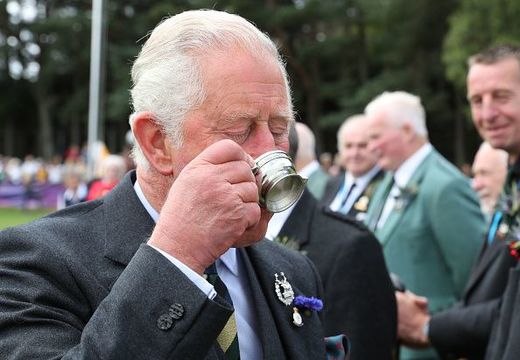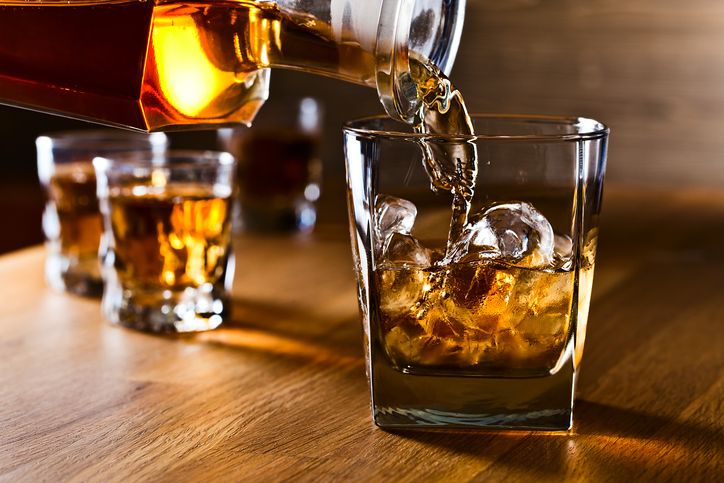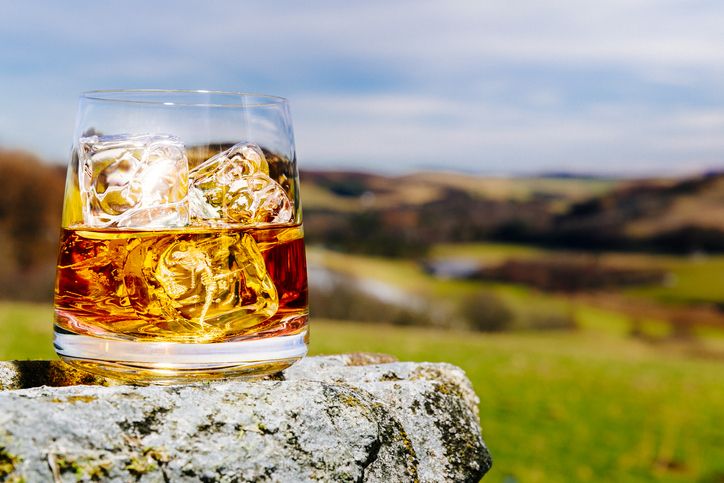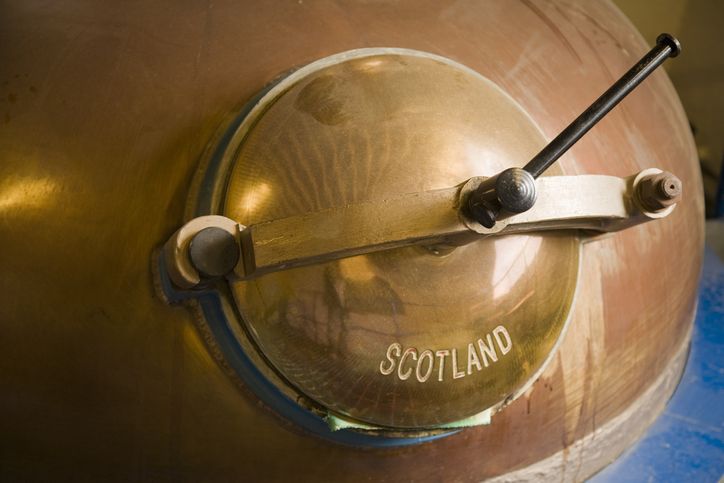
Prince Charles, Duke of Rothesay, is offered a whisky from Clan Farquharson President, Alan Caig, (not seen) as he attends the Ballater Highland Games on August 8, 2019 in Ballater, Aberdeenshire. (Photo by Andrew Milligan - WPA Pool/Getty Images)Image: Getty Images
Ask anyone from outside Scotland about their image of the country and the most likely responses will be tartan, bagpipes, Highland Games and, of course whisky
The origins of distilling spirits are lost in the mists of time, but are thought to have come from ancient Egypt. No matter the truth of that story, the process quickly spread through Europe and, certainly as far as whisky was concerned, was taken up enthusiastically by the Scots and Irish.
Originally, whisky was known as aqua vitae, or in the Gaelic, usquebaugh, both literally meaning “water of life.” The mispronunciation of the Gaelic version, pronounced “ooshkeba” and later corrupted to uiskie, gave rise to the word whisky.
The first written mention of whisky was in 1494 in the Scottish Exchequer Roll, when Friar John Cor of Lindores Abbey was given eight bolls (a boll = 140 pounds) of malt “to make aqua vitae.” In those days whisky was used for a number of purposes, including the manufacture of gunpowder, alchemy and even as a medicine. The Scots have been drinking it, purely for its medicinal qualities of course, ever since.

Whiskey and natural ice on old wooden table
Read more: Full English: Guide to a proper fry up
Scotch
These days, Scotch—a term rarely if ever used by Scots themselves—is drunk all over the world and is one of Scotland’s principal exports, earning dollars and a host of other currencies. In 2013, exports of Scotch to the U.S.A. grew 8 percent on the previous year to a record £819 million. That represents 127.3 million bottles of Scotch.
Scotch falls in to one of three categories: malt, grain and blended whisky. The product of all malt distillers is a single malt (i.e. the produce of a single distillery). A blend is made by mixing several malt and grain whiskies. Malts are drunk by those with a detailed knowledge of whisky, but blended whiskies are generally more popular.
The Aberfeldy distillery, home of the Aberfeldy Malt and the Dewar’s blend has won more than 400 awards and is the No. 1 seller in the U.S.A. The staff explained the whisky-making process to me.
These days, many distilleries buy in their malted barley, but the process remains the same as it has always been. Barley is soaked for four or five days to allow the grain to germinate, which makes the enzymes in it convert the starch into sugar. The barley is then heated over a peat or coal fire to dry it out and stop germination. As it is being dried, the barley absorbs some of the smoke, and that is what gives the end product its uniquely peaty favor.

Glass of whisky on the rocks, literally and metaphorically, outdoors in the Scottish Highlands AdobeRGB colorspace.
The process
The pagoda-like structures, which make older distilleries easily recognizable, were the kilns used for the malting process.
The dried grain is passed through a malt mill, simply a grinding process, into coarse four or grist, to make sugar extraction easier. The grist is then mixed with hot water in a vessel called a mash tun to remove the sugar.
To make sure all the sugar is removed, water, at different temperatures, 64, 77 and 85 degrees centigrade, is added to dissolve the sugar into a liquid termed wort. This is pumped into another vessel (a wash back), where fermentation is carried out by adding yeast to produce alcohol. This takes around 70 hours and produces a wash that is eight or nine percent alcohol and tastes like a crude beer.
The wort is pumped through to copper pot stills for distillation. There the liquid is boiled. The alcohol vaporizes first, and as it rises it goes through a cold water condenser that turns the vapor back into liquid. This liquid, known as low wines, is around 23 percent alcohol. A second distillation produces a spirit of roughly 70 percent alcohol.
The spirit is matured, generally in casks that have been used for bourbon or sherry. Brand new casks would react with the spirit to affect the favor adversely.

Scotch Whisky Barrel rows. Whiskey and brandy distillery. Oak barrel used to age whiskey.
Read more: Say Cheese!
What makes it scotch?
To be Scotch whisky, the spirit must mature a minimum of three years in oak casks in a warehouse in Scotland, but generally whisky is matured for much longer. The Aberfeldy distillery produces two malts, a 12-year old and a 21-year old, matured for those periods.
Maturation is important in the production of whisky as that is when the favors and aromas develop. Some two-thirds of the characteristics of any whisky occur during maturation. Once whisky is in the bottle, maturation ceases and the contents will not change in character no matter how long you keep them. Since oak casks are porous (allowing the whisky to breathe), an amount is lost to the atmosphere—a condition wonderfully described as “the angels’ share.”
Each distillery produces only single malt or single grain whisky. The blends so widely drunk are created by mixing several single malts with single grain whiskies—made from any grain, not just barley. Blending is not done in a haphazard manner; it is a process requiring a great degree of skill.
At Aberfeldy, up to 40 different whiskies from 40 different distilleries are used to create the Dewar’s blend. The resultant whisky never noticeably varies. On occasion, however, not all 40 of the required malts may be available, and a replacement may be needed to balance the favor. Since smell is more sensitive than taste, this is done by nosing; the master blender is responsible for the consistency of the end product. He knows by smell the characteristics required to maintain the unique favor blend.
That doesn't explain why individual whiskys are so different. The ingredients—barley and other grain, water, peat—are the same, but these elements often vary considerably in nature and so produce whiskies with a variety of tastes and aromas.
The copper pot stills are of different dimensions, although they are basically of the same design throughout the industry. Nevertheless, when ordering replacement stills, distillery managers have been known to ask for every bump and dent to be replicated, just in case it affects the spirit produced. Generally speaking, taller, thinner stills produce a lighter tasting whisky, while shorter, wider stills produce a slightly more oily whisky.

Detail of a pot still in whiskey distillery
Variations throughout Scotland
Even climate is important. Certainly the distilleries in the five different whisky-producing regions of Scotland produce a wide variety of malts. The whiskies produced in each region tend to have shared characteristics.
More than half of Scotland’s distilleries are in Speyside, eastern Highland Scotland around the River Spey. There is an abundance of rivers and burns (highland streams) such as the Livet and Fiddich, that supply the water, and often give their names to the whisky produced: Glenlivet and Glenfddich, for instance—the valley of the Fiddich or the Livet.
Peat is available in quantity there, too. Those materials (coupled with a long history in making illicit whisky) meant that the people of the area had a head start when it came to producing Scotland’s national drink.
These days, the product of Speyside is a light, extremely drinkable, malt, which is excellent drunk on its own or as a constituent in blended whisky.
The rest of Scotland north of an imaginary line drawn between Greenock in the west and Dundee in the east is known as the Highland region. There the distilleries closest to the sea are credited with producing malt with a salty tang, while those inland create malts more likely to evoke heather and most, although not heavily peaty, have a tinge of smokiness.
South of that imaginary line is the Lowland region, where the distilleries tend to produce malts that are lighter and sweeter than their Highland counterparts, and are less peaty in favor.
Campbeltown on the Argyll peninsula is another whisky region, although its capacity is much reduced from the 30 or so distilleries based there several decades ago. Because of the proximity to the sea, the malts produced there have a salty tang.
The islands of the Inner Hebrides are the other principal whisky-producing region. Much of the distilling industry is concentrated on Islay, where there are eight distilleries with another being built. Island malts are totally different from their mainland counterparts, and range from full-bodied oily malts and peaty-favored malts to lighter whisky, tinged by the sea. Island malts have strong favors, and, although they are an acquired taste, many aficionados drink nothing else.
The imposition of duty on spirits over the centuries made the distilling of illicit whisky and smuggling the finished product extremely attractive, and for a time these trades were rife. At one point, Corgarff Castle in the Highlands was occupied by troops in an attempt to put an end to the trade in the illicit whisky. In the early years of the 20th century one old crofter regularly recalled how, as a small boy, he had helped his father carry kegs of whisky to the castle for selling to the garrison. The joke, as he was fond of telling his listeners, was that every drop was contraband!
Ah, the whiskies of Scotland are eminently drinkable. There is no surer way of absorbing yourself in Scottish culture than having a dram or two.

Whisky casks / barrels in Speyside, Scotland
Read more: The joys of English cider
On the trail of Whisky
The vast majority of distilleries welcome visitors. Most make a charge, usually £5 to £10, for a tour that includes a dram at the end of it. Usually part of the admission charge can be redeemed by purchasing a bottle of their product.
For the connoisseur who wants learn more about whisky, there are more expensive deals available to provide a wider tasting experience or even put together your own blend. A readily available whisky map of Scotland shows the locations of almost 120 distilleries.
The Speyside Malt Whisky trail covers eight distilleries: Benromach, Dallas Dhu, Cardhu, Glen Moray, Glenlivet, Glenfddich, Glen Grant and Strathisla, although the region is home to many more. This trail also includes the Speyside Cooperage where craftsmen repair around 100,000 oak casks a year for the whisky industry.





Comments